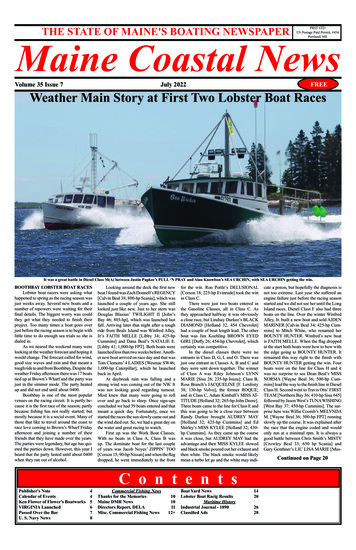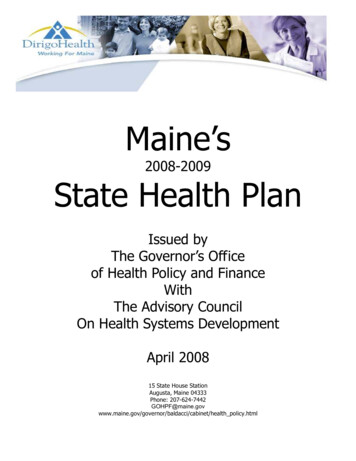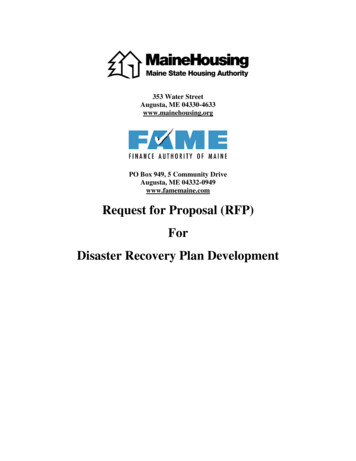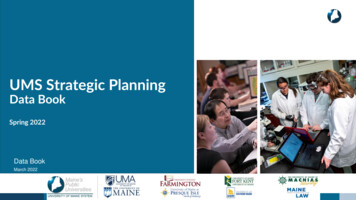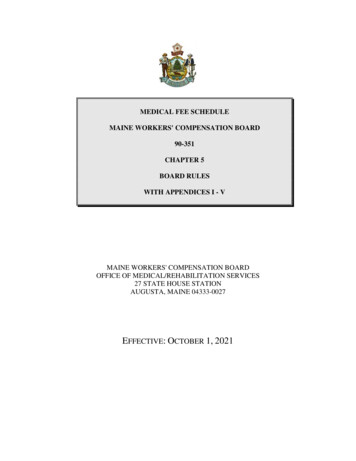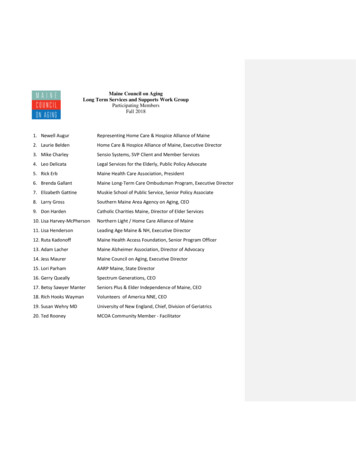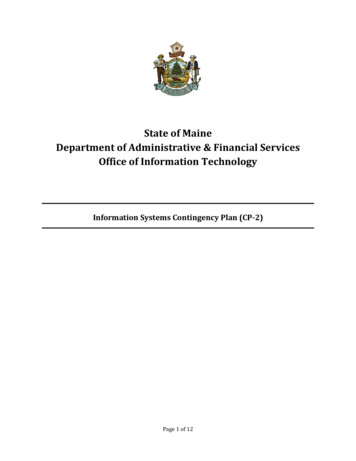
Transcription
State of MaineDepartment of Administrative & Financial ServicesOffice of Information TechnologyInformation Systems Contingency Plan (CP-2)Page 1 of 12
Information Systems Contingency Plan (CP-2)Table of ContentsTable of Contents . 21.0 Document Purpose: . 32.0 Scope: . 33.0 Plan Conflict: . 34.0 Situation: . 35.0 Mission: . 46.0 Management Intent: . 47.0 Constraints: . 48.0 Facts: . 59.0 Planning Assumptions: . 510.0 Concept of the Operation: . 511.0 Procedures: . 612.0 Document History and Distribution:. 1013.0 Document Review: . 1114.0 Records Management: . 1115.0 Public Records Exceptions: . 1116.0 Definitions: . 11Appendix A – Information Asset Ownership . 12Page 2 of 12
Information Systems Contingency Plan (CP-2)1.0Document Purpose:The purpose of this document is to describe how the Office of InformationTechnology (OIT) will assess and recover State of Maine systems hosted by OIT,following a disruption.2.0Scope:2.1 This plan applies to all State of Maine employees and contractors (collectivelyreferred to as personnel in this document) with access to:3.02.1.1Executive Branch Agency information assets, irrespective of location;and2.1.2Information assets from other State government branches that use theState network.Plan Conflict:If this plan conflicts with any law or union contract in effect, the terms of theexisting law or contract prevail.4.0Situation:4.1 OIT provides central leadership and vision in the use of information andtelecommunications technology on a statewide basis.4.2 OIT provides essential technology support and strategic leadership for 12,000Executive Branch employees, 14 Cabinet-level departments, and all the smallerExecutive Branch Agencies. It also provides network support for the JudicialBranch, Secretary of State, and Attorney General.4.3 OIT also provides technology support to Maine citizens. Examples of thissupport includes the Maine.gov web portal, the MSCommNet public safetyradio communications network, and the ConnectME broadband accessexpansion.4.4 In addition to the technology owned and operated by OIT, a number of vendormanaged services and systems provide direct support to the groups stated in4.2 and 4.3.4.5 Additional situation details can be found in the OIT Cyber Incident ResponsePlan (coming soon)Page 3 of 12
Information Systems Contingency Plan (CP-2)5.0Mission:5.1 An effective mission statement articulates the primary task and purpose of theplan. The primary task is identified by the fact, if an organization fails toachieve this task, the mission has failed. In this case the key task is conductingpersistent recovery procedures.5.2 OIT conducts persistent recovery procedures for the data and State of Maineinformation assets that enable the mission and business functions of supportedagencies.6.0Management Intent:6.1 The management intent communicates the key tasks and desired end state ofthe plan to the agency. It is written in such a way the organization can continuewith the plan absent continual executive level guidance. It is important that themanagement intent be written so it can be communicated to anyone involvedwith the plan.6.2 The key tasks are the overarching behaviors or actions that management wantseveryone to exhibit or complete during all phases of the plan.6.3 The desired end state articulates what the situation should be after thesuccessful completion of the plan.6.4 Key to the success of this transition is the following:6.4.1The confidentiality, integrity, and availability of the information assetsremains the highest priority.6.4.2OIT must know the status of information assets on a continuous basis.6.4.3OIT must work in cooperation with supported agencies to establish thepriority of recovery efforts.6.4.4Agencies that contract for vendor managed technology services andassets required by OIT supported agencies must have equivalentrecovery procedures for all contracted services.6.5 Desired end state: OIT maintains essential organizational missions andbusiness functions despite an information asset disruption.7.0Constraints:7.1 Business impact analysis (BIA) and contingency plans (e.g., business continuityplans (BCP)) of supported agencies are in various stages of development.Page 4 of 12
Information Systems Contingency Plan (CP-2)7.2 Coordination of contingency plan operations as a function of the continuity ofgovernment have not been established or exercised.7.3 The OIT disaster recovery plan (DRP) needs to be created to reflect currentstate.8.0Facts:8.1 The Office of Information Technology has finite capacity to recover fromdisruptions. Recovery from large magnitude outages, such as a disaster, willextend beyond the capacity of OIT, and will require additional resources.8.2 The scope of a disruption often extends beyond just the assets that OIT isresponsible for. This makes the identification of dependencies andcoordination with other plans essential.9.0Planning Assumptions:9.1 An outage of a magnitude to be considered a disaster (that is, requires therestoration of essential functions at another location) is handled as a part of thedisaster recovery plan (DRP).9.2 The recovery of information assets because of a cyber incident will be managedas a part the OIT Cyber Incident Response Plan (coming soon)9.3 As the procedures for the recovery of information assets are developed, theywill be added and maintained as a part of this plan.10.0 Concept of the Operation:10.1 This contingency plan occurs in four phases. The phases represent a naturalprogression and subdivision of the plan. These phases should be conceived incondition-driven, rather than time-driven, terms. The intent of each phase torecover information assets to bring the agency back to phase I conditions.10.2 Phase I- Preparation: OIT is in this phase when the confidentiality, integrity,and availability of the information asset is intact and ends upon notificationthat an information asset is not available. Generally, the preparation phaseincludes actions to:10.2.1 Improve the resiliency of the information asset from an outage10.2.2 Maintain backups of data to meet recovery objectives10.2.3 Maintain customer support services to enable the reporting of outages10.2.4 Improve the contingency planPage 5 of 12
Information Systems Contingency Plan (CP-2)10.2.5 Execute the training, testing, and exercises of the plan as outlined inContingency Plan Training, Testing and Exercise Procedures (IR-2, CP-3,IR-3, and CP-4) (coming soon).10.3 Phase II- Notification: This phase begins upon notification that an informationasset is not available by either external agencies or internal business unitsresponsible for an information asset. The phase ends when procedures torestore an information asset begin. Generally, the notification phase includesactions to:10.3.1 Continually monitor the availability of assets10.3.2 Manage customer feedback10.4 Phase III- Response: This phase begins when procedures to restore aninformation asset are started and ends with the restoration of the informationasset. Generally, the response phase includes actions to recover specificinformation assets.10.5 Phase IV- After Actions: This phase begins with the restoration of theinformation assets and ends with the completion of reporting requirements ofthe outage. Generally, the after actions phase includes actions to complete:10.5.1 Reporting requirements of customer support requests10.5.2 Required after action reporting requirements10.5.3 Updates to the plan as required11.0 Procedures:11.1 Phase I Preparation:11.1.1 OIT Information Security conducts training of contingency plans asoutlined in Contingency Plan Training, Testing and Exercise Procedures(IR-2, CP-3, IR-3, and CP-4) (coming soon).11.1.2 OIT headquarters and both data centers have backup power generatorsin the event of an outage.11.1.3 Both data centers have two access points to the internet via theUniversity of Maine.11.1.4 OIT sections with vendor provided maintenance for IT systems ensurecontractual obligations are met and agreements are kept up to date.11.1.5 Software is updated to the latest supported version.Page 6 of 12
Information Systems Contingency Plan (CP-2)11.1.6 Infrastructure that provides a redundant capability is maintained at ahigh state of readiness.11.1.7 Advanced notification is required when an operating platform isreaching end of life and databases must be moved.11.1.8 An on-call roster and contact information is posted on the Core NetworkStatus and News (CSN) intranet page. This roster includes the followinginfrastructure asset owners who are on call after normal business hoursto respond to asset outages:11.1.8.1 Security Infrastructure11.1.8.2 Network monitoring, Intrusion Detection System (IDS)11.1.8.3 Network services11.1.8.4 Voice services, Voice Over IP (VoIP)11.1.8.5 Data center infrastructure11.1.8.6 Network Core11.1.8.7 Wireless11.1.9 Information asset owners also take actions to prepare for and preventthe occurrence of outages specific to the technologies that they support.A list of information asset owners can be found in Appendix A.11.1.10 Domain Name Service (DNS): Conducts nightly automated and weeklymanual database backups. Failover exercises are conducted as a part ofall upgrades.11.1.11 IT Desktop Support/Field Services: Conducts testing for building outagescenarios. A supply of at least Personal Computers (PCs) are kept instock to meet emergency needs. The Dell and Hewlett Packard (HP)purchase agreements are maintained to meet additional needs of agencyoutages.11.1.12 High Speed Application Printing: Performs regular maintenance ofsystems to include weekly cleaning.11.1.13 Enterprise Operations Monitoring (EOM): Maintains documentation in acollaborative manner for the recovery of systems using Wiki pages onConfluence.11.1.14 Unix: Failover tested during regular patching and storage supports Unixwith daily backups.Page 7 of 12
Information Systems Contingency Plan (CP-2)11.1.15 Firewall: Failover exercised approximately twice per month duringstandard operation (e.g., routing traffic for Gigamon maintenance).11.1.16 Remote access/Virtual Private Network (VPN): Create backup imagesmonthly and conduct failover exercises during upgrades.11.1.17 Network core: Conduct a failover test at inception.11.1.18 Email (Microsoft Office 365/O365): Maintain three active copies ofemail located at various datacenters across the country.11.1.19 SQL Servers / Databases: SQL backups are performed nightly on alldatabases using an agent from Commvault. SQL Always On is availablefor databases requiring high availability. SQL Clustering is available forapplications requiring high availability and transaction log backups areused, by request, for point in time restores.11.1.20 Virtual Machine (VM) environment: VM guests are backed up byCommvault. For larger VMs requiring large amounts of RDM (RawDevice Mapping) storage, an iData agent is installed on the server for afull Commvault restore of the VM and storage space. Restores areperformed frequently for VM snapshots and with each new operatingplatform.11.1.21 Windows servers operating platform: All new servers go through thequality assurance/quality control process which includes checking tosee that the server has been added to Commvault backups. TheWindows server itself is backed up nightly by Commvault with one full aweek and 6 incremental backups. An iData agent from Commvaultprovides the means to restore a physical server. Restoration is tested ona physical server every time we have a new operating platform.11.1.22 File and print: Remote file servers are backed up in near real time usingCDR (Continuous Data Replication). Backup is done in near real-time bylogging all file write activity to a replication log in the source computer,including new files and changes to existing files. The replication log issent to a CDR server which is then backed up. Commvault backups onfile shares are in place for individual file restores on user’s shares.11.1.23 Directory services (Active Directory (AD) and supporting servers): Theentire structure is virtual with VM guests being backed up byCommvault. Directory services maintain redundant domain controllersand other support servers (another means of restoring an environmentif needed). They also maintain individual restores for Group PolicyObjects (GPOs) with AD Tombstone which is available for 180 days.Page 8 of 12
Information Systems Contingency Plan (CP-2)11.1.24 Storage: Ensures that the scheduled daily, weekly, and monthly backups(both incremental and full) are conducted. Passive hardware presence ismaintained to automatically take over in the event of an active failover.Appliances at operating system (OS) levels are kept current. Premiumhardware and software support are maintained on all appliances.11.1.25 Backups: Tape libraries are kept at a current operating system. Themedia agents for Windows servers have redundancy built-in with threeprimaries in each data center. Patch maintenance is performed asupdates are made available.11.1.26 Additional details about storage and backup can be found in MediaProtection Policy and Procedures (MP-1) (coming soon).11.2 Phase II Notification:11.2.1 A disruption could be reported by users, external entities (e.g., MultiState Information Sharing and Analysis Center (MS-ISAC)), 3rd partyvendor (e.g., Harris, Microsoft), automated alert (e.g., WebNM), or viaautomated notification / observation of the technology itself to / byinfrastructure asset owners.11.2.2 Reports from users would most likely go to the OIT Help Desk phone orthrough a Footprints ticket. The OIT Help Desk would involve theappropriate technicians to remediate the disruption. The OIT Help Desknotifies OIT Information Security if a request is determined to be relatedto a cyber incident.11.2.3 After normal business hours, reports from users would most likely go toEnterprise Operations Monitoring (EOM) via the OIT Help Desk phone.EOM notifies on call support to restore systems as required.11.2.4 For database issues related to physical access the Bureau of GeneralService (which is the application owner) are notified.11.2.5 All information assset recovery from notification to after actions isultimately documented in Footprints.11.3 Phase III Response actions:11.3.1 The restoration of information assets must occur without thedeterioration of the security safeguards originally planned andimplemented.11.3.2 Asset owners typically assess any disruptions and conduct remediationto restore information assets to a fully operational capability. AssetPage 9 of 12
Information Systems Contingency Plan (CP-2)owners maintain the trained staff and documented procedures specificto the technologies that they support.11.3.3 Information assets with a redundant capability rely on the availablesystem until the disrupted system is restored.11.3.4 Information assets with failover capabilities previously described areutilized when the main system fails.11.3.5 Back-ups and roll-back capabilities may also be leveraged for therestoration of information assets.11.3.6 Vendor support is utilized as required to restore information assets.11.3.7 Select hardware may be replaced under either a full or limited warranty.11.4 Phase IV After Actions common to all information assets, whereapplicable:11.4.1 Significant incidents require an after action report (see Cyber IncidentReporting Procedures (IR-6), Appendix E “Formal After-Action Review(AAR) Report” (coming soon))11.4.2 Internal procedures are updated as required. Internal knowledgetransfer to team leads and members, including lessons learned occur forunique outages.11.4.3 Communication of the restoration of information assets are conductedby footprints, email, and CNN.12.0 Document History and Distribution:VersionRevision LogDateVersion 1.0Initial PublicationAugust 23, 2019Approved by: Chief Information Officer, OIT.Legal Citation: Title 5, Chapter 163: Office of Information Technology1.DistributionThis document will be distributed to all appropriate State of Maine personnel andwill be posted on the OIT website ec0.htmlPage 10 of 12
Information Systems Contingency Plan (CP-2)13.0 Document Review:This document is to be reviewed annually and when substantive changes are madeto policies, procedures or other authoritative regulations affecting this document.14.0 Records Management:Office of Information Technology security policies, plans, and procedures fall underthe Routine Administrative Policies and Procedures and Internal Control Policies andDirectives records management categories. They will be retained for three (3) yearsand then destroyed in accordance with guidance provided by Maine State Archives.Retention of these documents will be subject to any future State Archives GeneralSchedule revisions that cover these categories.15.0 Public Records Exceptions:Under the Maine Freedom of Access Act, certain public records exceptions may limitdisclosure of agency records related to information technology infrastructure andsystems, as well as security plans, procedures or risk assessments. Informationcontained in these records may be disclosed to the Legislature or, in the case of apolitical or administrative subdivision, to municipal officials or board membersunder conditions that protect the information from further disclosure. Anyaggrieved person seeking relief for an alleged violation of the FOAA may bring suitin any Superior Court in the state.16.0 Definitions:16.1Information Asset: Used interchangeably with Information System. Adiscrete, identifiable piece of information technology, including hardware,software, and firmware. Information assets include, for example,mainframes, workstations, servers (e.g., database, electronic mail,authentication, web, proxy, file, domain name), input/output devices (e.g.,scanners, copiers, printers), network components (e.g., firewalls, routers,gateways, voice and data switches, process controllers, wireless accesspoints, network appliances, sensors), operating systems, virtual machines,middleware, business applications, system software, development tools, andmiscellaneous related utilities.16.2Recovery Procedures: Actions necessary to restore data files of aninformation system and computational capability after a system failure.SOURCE: CNSSI-4009.Page 11 of 12
Information Systems Contingency Plan (CP-2)Appendix A – Information Asset OwnershipOwnerApplication DevelopmentManagersClient TechnologiesComputing Infrastructure andServicesEnterprise Data ServicesInformation Security OfficeNetwork and Data CenterNetwork and Data CenterInformation AssetBusiness ApplicationsEnterprise Operations Monitoring (EOM)FirstNetHigh Speed Application PrintingIT Desktop Support/Field ServicesIT Radio Operations (MSCommNet)BackupsDirectory services (Active Directory andsupporting servers)Email (Microsoft Office 365/O365)File and printSQL servers: SQL databasesStorageVirtual Machine (VM) environmentWindows servers operating platformOracle Database, Oracle MiddlewareUnixNetwork monitoring, Intrusion Detection System(IDS)Physical Access (Badges)Security InfrastructureData center infrastructureDomain Name Service (DNS)FirewallNetwork coreNetwork servicesRemote access/Virtual Private Network (VPN)Voice services, Voice Over IP (VoIP)Web Application Firewall (WAF), DistributedDenial of Service (DDoS) protection, ReverseProxyWirelessPage 12 of 12
databases using an agent from Commvault. SQL Always On is available for databases requiring high availability. SQL Clustering is available for applications requiring high availability and transaction log backups are used, by request, for point in time restores. 11.1.20 Virtual Machine (VM) environment: VM guests are backed up by Commvault.

